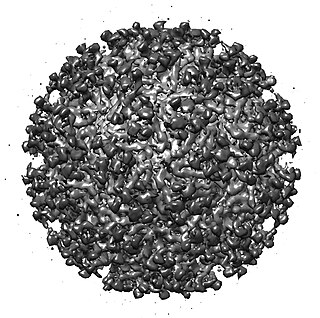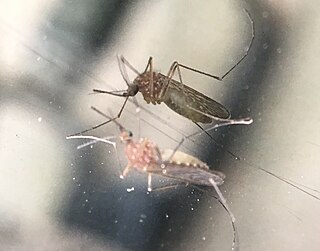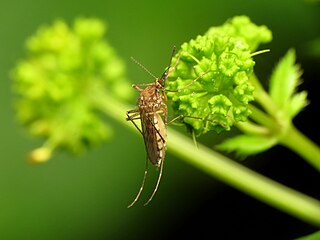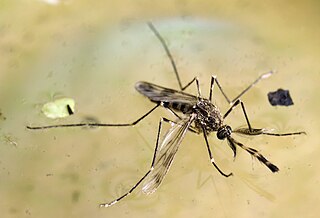
Rift Valley fever (RVF) is a viral disease of humans and livestock that can cause mild to severe symptoms. The mild symptoms may include: fever, muscle pains, and headaches which often last for up to a week. The severe symptoms may include: loss of sight beginning three weeks after the infection, infections of the brain causing severe headaches and confusion, and bleeding together with liver problems which may occur within the first few days. Those who have bleeding have a chance of death as high as 50%.

Mosquitoes are approximately 3,600 species of small flies comprising the family Culicidae. The word "mosquito" is Spanish for "little fly". Mosquitoes have a slender segmented body, one pair of wings, one pair of halteres, three pairs of long hair-like legs, and elongated mouthparts.

Arbovirus is an informal name for any virus that is transmitted by arthropod vectors. The term arbovirus is a portmanteau word. Tibovirus is sometimes used to more specifically describe viruses transmitted by ticks, a superorder within the arthropods. Arboviruses can affect both animals and plants. In humans, symptoms of arbovirus infection generally occur 3–15 days after exposure to the virus and last three or four days. The most common clinical features of infection are fever, headache, and malaise, but encephalitis and viral hemorrhagic fever may also occur.

Culex (Culex) tritaeniorhynchus is a species of mosquito and is the main vector of the disease Japanese encephalitis. This mosquito is a native of northern Asia, and parts of Africa. Females target large animals for blood extraction, including cattle and swine, and are strongly anthropophilic.

Everglades virus (EVEV) is an alphavirus included in the Venezuelan equine encephalitis virus complex. The virus circulates among rodents and vector mosquitoes and sometimes infects humans, causing a febrile illness with occasional neurological manifestations. Although it is said to be rare in humans it is still debated if this is the case because of the possibility of underdiagnosing as well as being a unrecognized cause of other illnesses. The virus is named after the Everglades, a region of subtropical wetlands in southern Florida. The virus is endemic to the U.S. state of Florida, where its geographic range mirrors that of the mosquito species Culex cedecei. Hispid cotton rat and cotton mouse are considered important reservoir hosts of Everglades virus. Most clinical cases of infection occur in and around the city of Miami. The abundance in clinical cases in certain parts of Florida comes from many factors such as population density and proximity to the hosts and their ecosystem.

Culiseta is a genus of mosquitoes. Most Culiseta species are cold-adapted, and only occur in warmer climates during the colder parts of the year or at higher elevations where temperatures are lower. Species found in Southern California are larger than most mosquitoes species, specifically Cs. inornata, Cs. particeps, and Cs. incidens. These species are found throughout the year in Southern California and feed on several vertebrate species, such as birds, livestock, rodents, reptiles, and humans. The larvae of most species are found bogs, marshes, ponds, streams, ditches, and rock pools, but an African species occurs in tree holes ("phytotelmata"), a common eastern Palaearctic species occurs in water wells and rock pools, and several Australian species occur under ground. Little is known about the blood-feeding habits of females. Most species feed on birds and mammals, but a few feed on reptiles. Several species attack domestic animals and occasionally humans, and some species are pollinators.

Culex pipiens, commonly referred to as the common house mosquito, is a species of mosquito. House mosquitoes are some of the most common mosquitoes. More specifically, Culex pipiens is considered as the northern house mosquito, as it is the most common mosquito to the northern regions of the US. North of the 39th parallel north in the US, only C. pipiens are present, whereas south of the 36th parallel north, only C. quinquefasciatus are present. Additionally, they can be found in both urban and suburban temperate and tropical regions across the world.

Culex restuans is a species of mosquito known to occur in Canada, the United States, Mexico, Guatemala, Honduras, and the Bahamas. It is a disease vector for St. Louis encephalitis and West Nile virus. In 2013 West Nile Virus positive specimens were collected in Southern California.

Aedes vexans, the inland floodwater mosquito or tomguito, is a cosmopolitan and common pest mosquito. This species has been collected in southern California.

Culex tarsalis, also known as Western Encephalitis Mosquito, is a mosquito species that appears in southern California. The species has black and white banding on the legs.

Culex quinquefasciatus, commonly known as the southern house mosquito, is a medium-sized mosquito found in tropical and subtropical regions of the world. It is a vector of Wuchereria bancrofti, avian malaria, and arboviruses including St. Louis encephalitis virus, Western equine encephalitis virus, Zika virus and West Nile virus. It is taxonomically regarded as a member of the Culex pipiens species complex. Its genome was sequenced in 2010, and was shown to have 18,883 protein-coding genes.
Culex erythrothorax is a species of mosquito that appears in Southern California. It is also known as the tule mosquito due to its preference for breeding in tule plants. The species has a brownish-orange color. It is a confirmed vector of West Nile virus.
Aedes bahamensis, also known as Howardina bahamensis, is a mosquito native to the Caribbean and Bahamas, which was first discovered in two counties of southern Florida in 1986,. The females of the species do not require a blood meal to produce eggs, although they will bite if starved of nectar or in order to produce a second brood. They are thought to be capable of transmitting St. Louis encephalitis.

Anopheles freeborni, commonly known as the western malaria mosquito, is a species of mosquito in the family Culicidae. It is typically found in the western United States and Canada. Adults are brown to black, with yellow-brown hairs and gray-brown stripes on the thorax. Their scaly wings have four dark spots, which are less distinct in the male.

Culiseta incidens, the cool weather mosquito, is a species of mosquito in the family Culicidae. Specimens have been collected in Southern California.

Culiseta inornata, the winter marsh mosquito, or the unadorned American cool weather mosquito is a species of mosquito in the family Culicidae. This species is found in southern California.

Anopheles franciscanus is a species of mosquito in the family Culicidae. This species has been collected in southern California.
Culex stigmatosoma is a mosquito species that appears in Southern California, Oregon, and Texas. It is a confirmed vector of West Nile virus.
Culiseta particeps is a species of mosquito in the family Culicidae. It is found along the West coast of the United States including Southern California, Arizona as well as Mexico and Guatemala. Cs. particeps is not a known vector of human pathogens.

Anopheles hermsi is a species of mosquito in the family Culicidae. It is a known vector of Plasmodium vivax malaria. An. hermsi have been collected in Southern California.













